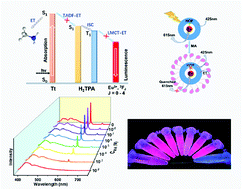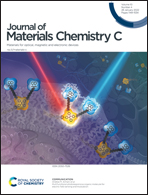Dual-emission ratiometric fluorescent probe-based lanthanide-functionalized hydrogen-bonded organic framework for the visual detection of methylamine†
Abstract
Developing a highly sensitive and selective visualized sensor for volatile organic amines is a challenge in materials science. Here, we report a Eu3+-functionalized hydrogen-bonded organic framework (HOF) (named Eu@Tt-TPA) for the ratiometric fluorescence detection of methylamine (MA). The unbonded carboxyl group in the structure can bind Eu3+ with the skeleton to produce double emission, and can also produce hydrogen bonds with the analyte MA. Eu@Tt-TPA exhibits a dual emission, at 425 nm for the HOF and 615 nm for Eu3+, under excitation at 310 nm, realizing the visual ratiometric detection of MA in aqueous solution. The ratiometric sensing performs a self-calibration effect and reduces the background. Furthermore, a portable gas sensor was prepared by solidifying Eu@Tt-TPA into a hydrogel using the sodium salt of hydroxymethyl cellulose. When exposed to MA vapor, this hydrogel-based sensor exhibits a distinct color change, which varied with the MA concentration. Thus, the dual emission ratiometric fluorescent probe Eu@Tt-TPA, for the simultaneous detection of MA liquid and vapor with high selectivity and sensitivity, a low detection limit (0.87 ppm) and recoverability, was achieved and investigated for use in wastewater.

- This article is part of the themed collection: Journal of Materials Chemistry C HOT Papers


 Please wait while we load your content...
Please wait while we load your content...